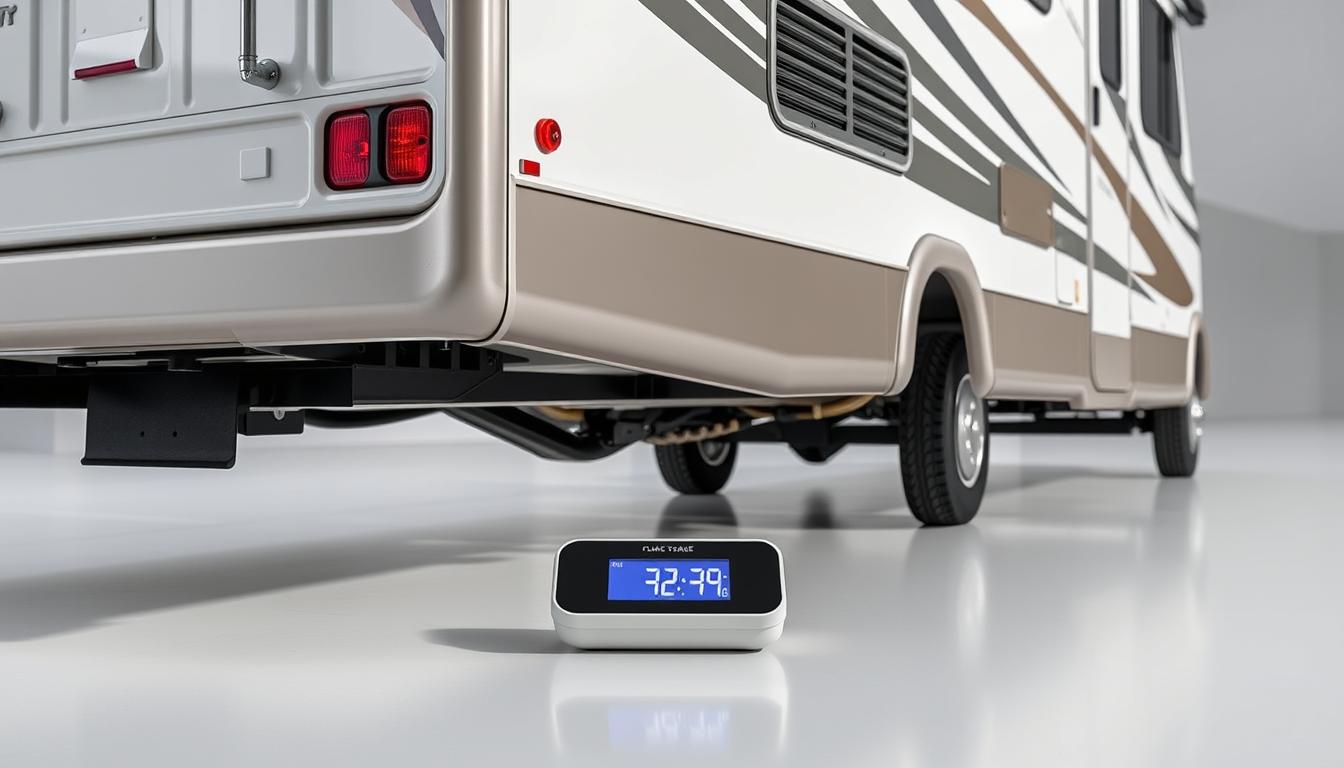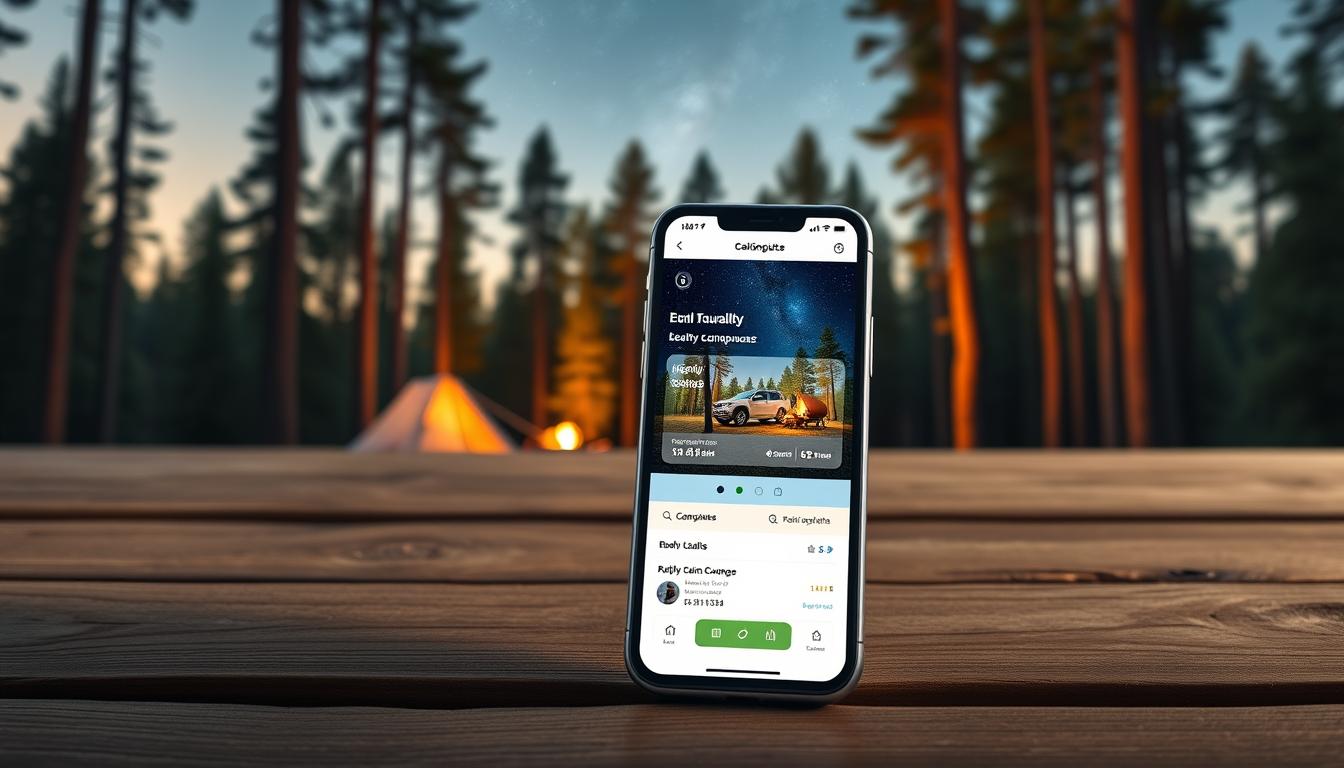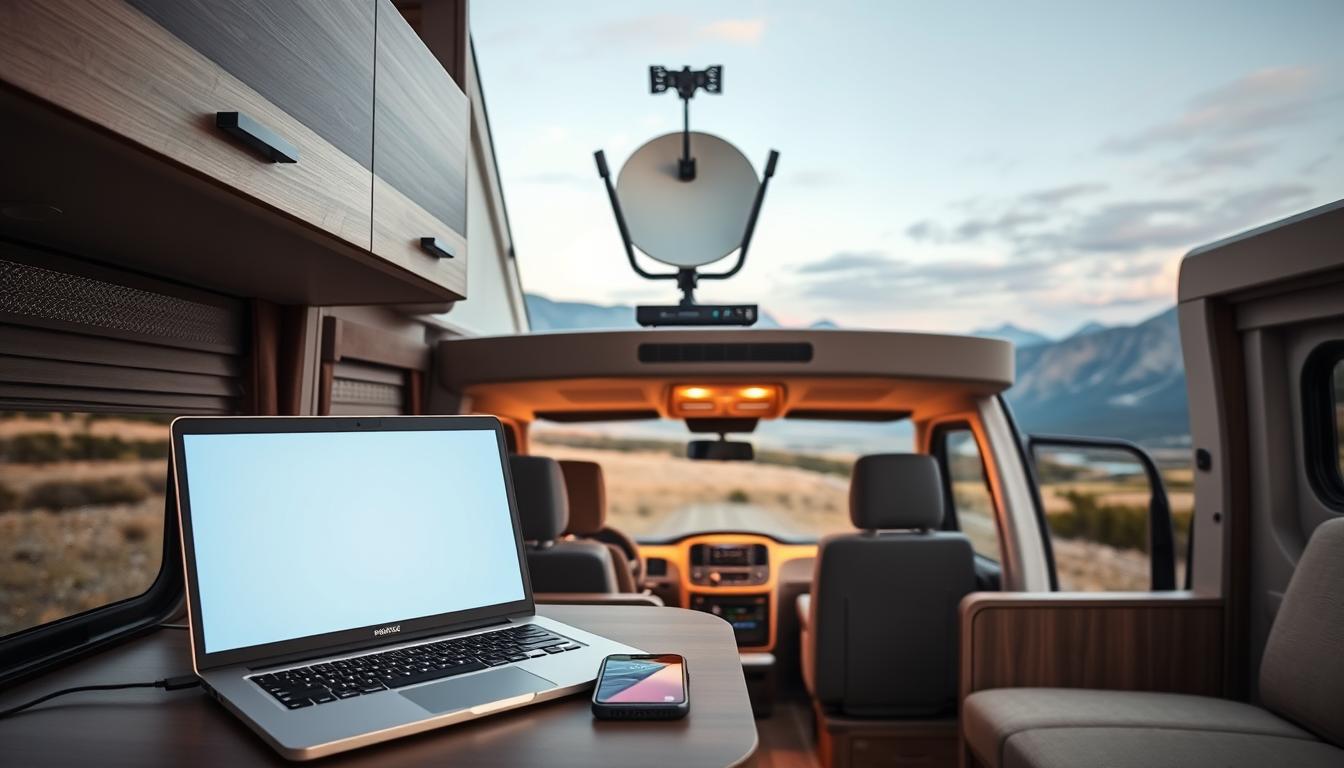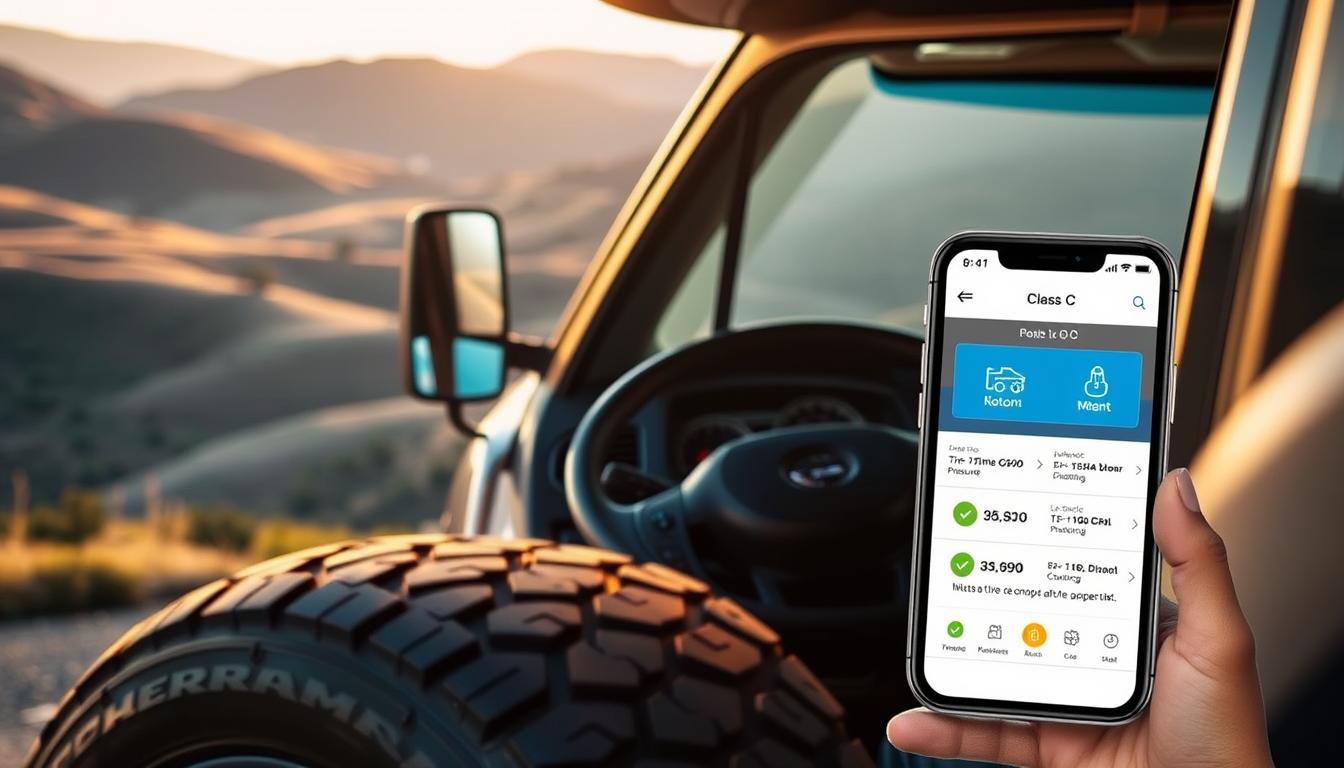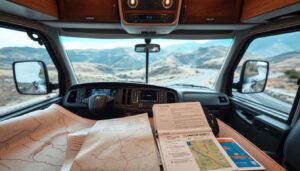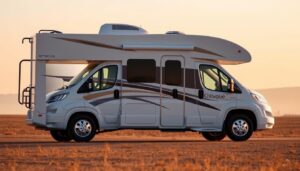How to accurately calculate total weight and load using apps for Class C motorhomes
Ever thought about your Class C motorhome’s true weight and how it affects your safety? Knowing the total weight and load of your RV is key for safe travel and following the law. Thanks to tech, especially weight load apps, measuring your RV’s weight is now easier than before. We’ll show you how to use these apps for accurate weight calculations, which is vital for all Class C motorhome fans.
Understanding the Importance of Accurate Weight Measurement
Getting the weight right is key for RV safety. Going over weight limits can make the RV hard to control, leading to accidents. It also helps you follow the law, avoiding fines or penalties.
Knowing the gross vehicle weight rating (GVWR) is vital. It keeps the RV running smoothly. Overloading can damage brakes, suspension, and tires, raising the chance of a breakdown. Owners who know this keep their RVs safe by sticking to weight limits.
Even weight distribution is also crucial. An uneven load can make the RV unstable, affecting how it handles. Spreading weight evenly improves safety and makes the RV last longer.
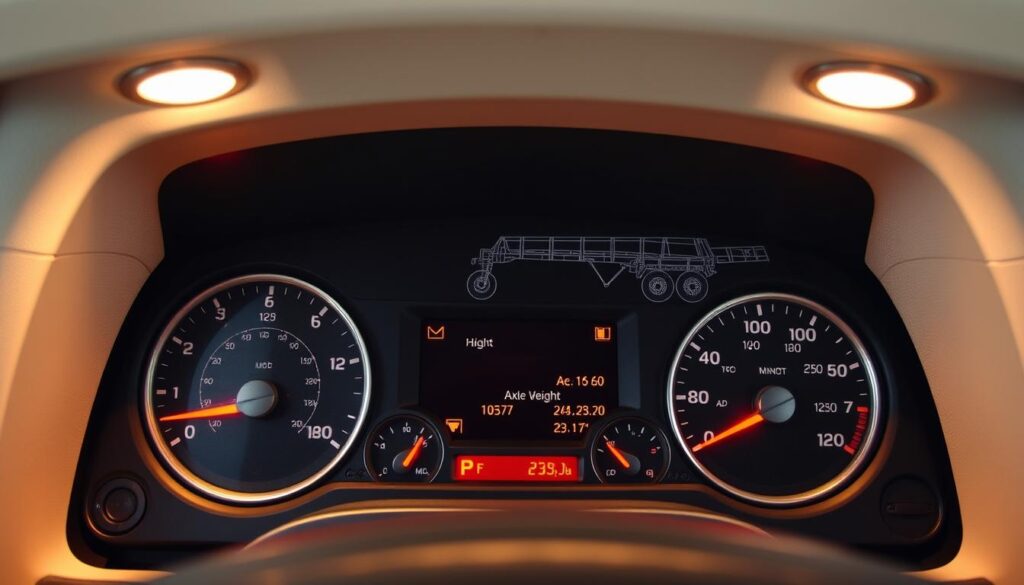
Key Weight Terminologies for Class C Motorhomes
Knowing RV weight terms is key for Class C motorhome owners. It’s important to understand GVWR, UVW, and payload. These terms help manage safety and efficiency while driving.
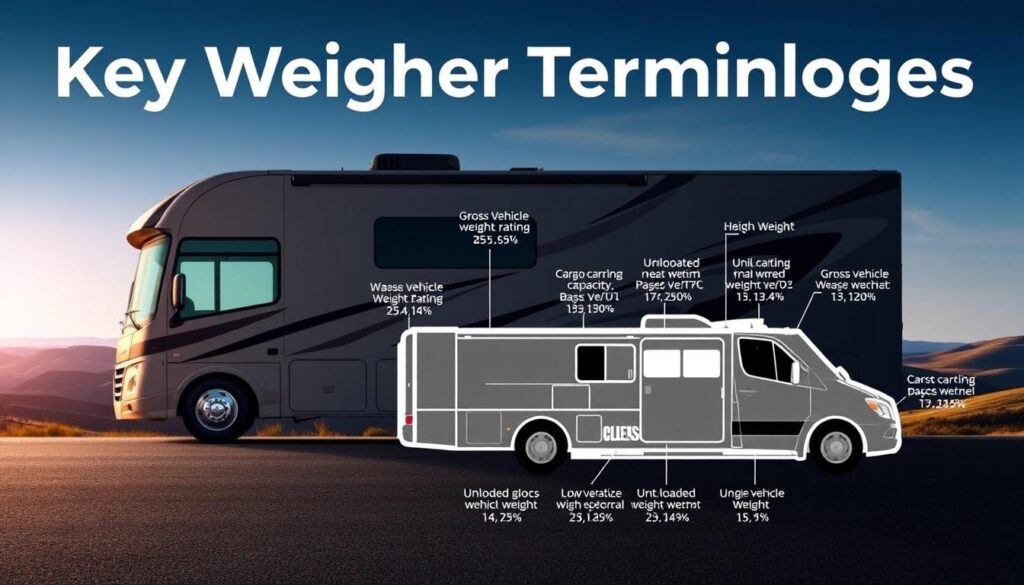
GVWR is the max weight a motorhome can handle, including its own weight and cargo. It’s crucial for safe driving. UVW shows the RV’s weight without liquids or cargo. This helps figure out how much extra weight is safe to add.
Payload is the RV’s total carrying capacity, found by subtracting UVW from GVWR. It’s vital for loading the RV right to keep it safe and running well. Knowing these terms helps owners make smart choices and enjoy their trips more.
Gross Vehicle Weight Rating (GVWR) and Its Significance
The Gross Vehicle Weight Rating (GVWR) is key for Class C motorhomes. It shows the max weight a maker says is safe to drive. This includes the vehicle itself and all cargo, passengers, and extra items.
Going over GVWR can hurt how well your RV drives and handles. It can also lead to legal trouble if checked by the cops. Insurance might not cover accidents if your RV is too heavy.
Keeping within GVWR is crucial for road safety. A balanced RV puts less stress on tires, brakes, and the body. This helps avoid accidents and keeps everyone safe.
What Happens If Your Class C Motorhome Is Overweight?
Driving an overweight Class C motorhome is risky. It affects both safety and how well the RV performs. Overloading makes it harder to control the vehicle, especially in different driving situations.
This loss of control also makes the RV less stable. This is a big problem for RV stability.
More weight means more wear and tear on important parts like tires and suspension. Not following weight rules can lead to legal ramifications, including big fines. Owners might also lose their warranties or insurance, leaving them at risk financially.
Also, an overloaded RV is more likely to break down. The extra weight stresses the engine and brakes, putting everyone’s safety at risk. Keeping an eye on the load and adjusting it can help avoid these dangers and make travel safer.
Steps to Prepare for Weighing Your Motorhome
Getting ready to weigh your RV is key for safety and following the law. First, pack your motorhome like you would for a trip. Include everyone, your stuff, and travel supplies. It’s important to have your RV set up the same way it is when you’re driving.
Then, check the levels of fuel, propane, and water. These affect your RV’s weight and should match your usual travel setup. Once your RV is ready, find a good weighing scale. Many people like CAT scales because they’re easy to use and found everywhere.
Before you start, learn how the scale works. Knowing this will make your first time easier. Also, be ready for lines and try to go when it’s not busy. By following these steps, you’ll get a precise weight for your motorhome.
How to Use Apps for Precise Total Weight Calculation with Load in Class C RV
RV weight calculation apps make it easy to figure out your Class C motorhome’s total weight and load. These apps have simple interfaces that make it easy to enter data. You can add things like axle weights and cargo to get accurate numbers.
These tools are great because they show how weight is spread out across axles. This helps you follow weight limits and stay safe on the road. Many apps also have graphs and charts to help you see weight distribution. This makes it easier to spot any weight issues.
When picking an app, think about what you need. Some apps let you save previous weights for easy tracking. Others work with Bluetooth scales for instant updates. Using these apps can make weighing your RV much simpler and safer.
| Feature | Mobile App A | Mobile App B | Mobile App C |
|---|---|---|---|
| User-Friendly Interface | Yes | Yes | No |
| Axle Weight Analysis | Yes | No | Yes |
| Graphical Weight Distribution | No | Yes | Yes |
| History Tracking | Yes | Yes | No |
| Bluetooth Compatibility | Yes | No | Yes |
Locating Weigh Stations for Class C Motorhomes
Finding weigh stations for Class C motorhomes is key for RV owners. It helps ensure their vehicles meet weight rules. Knowing where to find weighing facilities for big vehicles is important for safety and performance.
Mobile apps like Trucker Path and RV Life are great for finding weigh stations. They give real-time info and reviews from users. Websites like CAT Scale also list scales across different areas.
Local trucking spots often have weight stations open to the public. Calling them can tell if they let in RVs. When you get to a scale, make sure to follow any signs on how to park your motorhome.
| Weigh Station Type | Access Method | Typical Fees |
|---|---|---|
| CAT Scales | Mobile app or website | $10 – $15 |
| Local Trucking Facilities | Direct contact | $5 – $20 |
| Private Weigh Stations | Appointment necessary | $15 – $25 |
Getting a printout of your weight at the scale is important. It proves you’re following the rules and helps keep your load balanced. With the right tools, finding weigh stations is easy for Class C motorhome owners.
Understanding Load Distribution and Its Impact on Safety
Proper load distribution is key for your RV’s performance and RV safety. If the load is uneven, it can make steering hard and increase the stopping distance. This is a big risk on the road. To handle well, keep the weight balanced on both axles in your Class C motorhome.
Uneven loading can make one axle carry too much weight, going over the axle weight limits. This can wear out your motorhome faster and make it less safe. To stay safe, put heavy things lower and closer to the middle of the RV.
Moving things around can make your RV much more stable. Here are some tips for better load balance:
- Distribute heavy items evenly between the front and rear axles.
- Secure all items to prevent movement during travel.
- Use weight distribution hitches if towing another vehicle.
- Regularly check your motorhome’s balance using recommended methods.
By focusing on proper load distribution, you can make your RV safer, easier to handle, and more enjoyable to travel in.
Benefits of Weighing Your Motorhome Regularly
Regularly weighing your motorhome has many benefits. It helps you stay within legal weight limits, avoiding fines and dangers. This also improves your vehicle’s performance and fuel use, making your trips smoother and safer.
It’s important to weigh your motorhome as part of regular maintenance. If the weight changes, it might mean you need to adjust how you load it. This can help prevent mechanical issues and make your vehicle last longer.
Also, weighing your motorhome often is key to safety. It lowers the chance of tire blowouts and problems with stopping. Making weighing a regular part of your routine can make your travels safer for everyone.
| Benefit | Description |
|---|---|
| Legal Compliance | Avoid fines and ensure adherence to weight limits. |
| Vehicle Performance | Enhance fuel efficiency and handling while driving. |
| Maintenance | Identify load changes and prevent mechanical issues. |
| Safety | Reduce risks of blowouts and braking complications. |
Popular Apps for Total Weight Calculation
For RV owners, knowing the exact weight is key for safety and performance. Many RV weight apps have become vital for managing loads. They offer load tracking, weight analysis, and easy-to-use interfaces for RV fans.
The RV Weight Calculator is a top choice. It helps figure out total weight and how it’s spread out. Users can enter their RV’s details and cargo, getting a detailed weight report.
Here’s a look at some top apps:
| App Name | Key Features | User Rating |
|---|---|---|
| RV Weight Calculator | Load management, data tracking, intuitive interface | 4.5/5 |
| My RV Weight | Weight logging, calculator for various RV types | 4.2/5 |
| RV Life | Travel planning, weight calculations integrated | 4.6/5 |
| Load Weight Pro | Custom load tracking, notifications | 4.3/5 |
These apps offer great tools for RV owners. The right app can make weight calculations more accurate. This ensures safe and fun trips.
How to Data Entry for Weight Calculation Using Apps
Accurate data entry is key for precise weight calculations in RV apps. Each app has its own input needs. Knowing these can greatly improve your results. It’s helpful to get familiar with the app’s layout before starting.
First, collect all the info about your motorhome and its load. You’ll need:
- Gross Vehicle Weight Rating (GVWR)
- Vehicle weight without cargo
- Weight of the cargo, including any additional accessories
- Weight distribution across axles
When you enter data, check each number twice. Many apps show load distribution in an easy-to-understand way. Keeping your data entry organized helps avoid mistakes and ensures clear results.
Using weight calculation tutorials can guide you through app features. These tutorials often include visuals and step-by-step guides. They help both experienced and new RV owners manage their Class C motorhome’s weight better.
| Data Point | Details |
|---|---|
| Gross Vehicle Weight Rating (GVWR) | The maximum weight your motorhome is rated to safely carry. |
| Empty Vehicle Weight | Weight of the motorhome without any load, important for calculations. |
| Payload Capacity | Total cargo weight capacity, including passengers and gear. |
| Axle Weight Distribution | Weight distribution between the front and rear axles for stability. |
Using best practices for data entry in weight calculation apps leads to accurate results. This helps in better load management. RV owners can travel with confidence, knowing their vehicle is within safe weight limits.
Using Scale Printouts to Cross-Verify App Calculations
Scale printouts from certified weigh stations help RV owners check their app weights. They offer a solid way to compare official measurements with app data. Knowing how to read these printouts is key for accurate personal calculations.
To use scale printouts well, follow these steps:
- Get the scale printout after weighing your Class C motorhome. It will have axle weights and total weight details.
- Put the printout data into your app or a manual calculator for comparison.
- Look for any differences. This step helps in cross-checking calculations for any app vs. scale discrepancies.
By carefully comparing these, you boost the accuracy of weight measurements. It also builds trust in the app’s reliability. Doing this often ensures your total weight matches the accurate weights from weigh stations.
| Aspect | App Calculation | Scale Printout |
|---|---|---|
| Total Weight | 8,500 lbs | 8,600 lbs |
| Front Axle Weight | 4,000 lbs | 4,050 lbs |
| Rear Axle Weight | 4,500 lbs | 4,550 lbs |
Using scale printouts with apps helps understand your motorhome’s weight better. It leads to safer and more informed decisions.
Case Studies: Real-life Weight Calculation Experiences
RV owners can learn a lot from weight measurement experiences. Many have shared their stories of managing and calculating total weight. These stories show the ups and downs of the weighing process.
One owner, with a Winnebago View, learned a hard lesson. A small mistake led to overloaded axles on a long trip. They used a mobile app to fix this. This change made their journey safer and saved fuel.
Another owner, with a Forest River Sunseeker, worked on balancing weight. They moved some cargo to the front for better handling. Their story helps others make their trips safer and more fun.
These stories teach us important lessons. They remind us to weigh our RVs before we hit the road. They show how making small changes can make a big difference in our RV adventures. Sharing these experiences helps the RV community grow and learn together.
| Owner Type | Motorhome Brand | Issues Faced | Solutions Implemented |
|---|---|---|---|
| Long-distance Traveler | Winnebago View | Overloaded axles | Utilized RV weight app for recalibration |
| Weekend Adventurer | Forest River Sunseeker | Poor handling | Adjusted load distribution for balance |
Alternatives to Weighing Scales and Using Apps
When figuring out a Class C motorhome’s weight, scales and apps are usually the go-to. Some people look for other ways because they’re easier or more accessible. These options give a basic idea of weight and how to manage it.
One easy way is to guess the weight of things in the motorhome. You can use what you know about the weight of items. This method isn’t exact but gives a quick idea of how much you’re carrying.
Another good method is using load balance indicators in some motorhomes. These show how weight is spread out and warn of unbalanced loads. They don’t give exact weights but help make sure the weight is even, which is key for safe driving.
Here’s a look at some popular ways to weigh a motorhome instead of using scales:
| Method | Pros | Cons |
|---|---|---|
| Manual Weight Estimates | Simple to use and requires no additional tools. | Lacks precision; requires prior knowledge of items’ weights. |
| Load Balance Indicators | Helps with weight distribution and safety. | Does not provide exact weight; may not be available on all models. |
| Visual Inspection | Quick assessment of load distribution and overall balance. | May overlook hidden weight factors; subjective in nature. |
Trying out these other ways to weigh can be helpful if you don’t want to use scales or apps. What you choose depends on what you prefer, what you have available, and how comfortable you are with guessing weights and balance.
Conclusion
Knowing your Class C motorhome’s weight is key for safety and following the law. We’ve seen how accurate weight checks avoid fines and improve your RV trips. Using advanced apps and following guidelines helps RV fans manage their vehicle’s weight well.
Regular weight checks and proper load distribution are vital. They keep your motorhome balanced and safe, making your trips better. Taking care of your RV’s weight also keeps everyone on the road safe.
Being informed about weight and monitoring it brings peace of mind on trips. Get the right tools and know-how to handle RV weight management. Travel safely, knowing you’ve prepared well for the journey.
FAQ
Why is accurate weight measurement important for Class C motorhomes?
Knowing your RV’s weight is key for safety and following the law. Too much weight can hurt how your RV drives and make it more likely to crash. It also might get you in trouble with the law.
Understanding your RV’s total weight helps you stay safe and legal. It also makes your RV easier to handle and safer to drive.
What are GVWR, UVW, and GCCC?
GVWR stands for Gross Vehicle Weight Rating. It’s the max weight your RV can handle, including you and your stuff. UVW is the weight of your RV without any cargo or people.
GCCC, or Gross Cargo Carrying Capacity, is how much extra weight you can add to your RV. This includes cargo and fluids, but not the weight of the RV itself.
What are the consequences of overloading my Class C motorhome?
Overloading can make your RV harder to control and wear out your tires and suspension. You might also get fined for breaking weight rules.
It can make your RV unstable, increase the chance of mechanical problems, and even void your insurance.
What should I do to prepare for weighing my motorhome?
Pack your RV like you would for a trip, with everyone and all your stuff inside. Check your fluids, like fuel and water.
Find a good weighing scale, like a CAT scale, and learn how to use it. This is important for getting accurate weights.
How do mobile apps assist in calculating the weight of my motorhome?
RV apps make tracking your RV’s weight easy. They let you enter data to keep track of your RV’s weight and load. They also show how your weight is spread out, which helps you manage it better.
Where can I find weigh stations for my Class C motorhome?
You can find weigh stations at CAT scales in many places. You can also use apps, websites, or local truck stops to find them.
Why is proper load distribution important for my RV?
Proper load distribution keeps your RV safe and handles well. Uneven loading can make steering hard and increase stopping time. This can be dangerous on the road.
What are the benefits of regularly weighing my motorhome?
Regular weigh-ins keep you safe and legal. They help your RV perform better and make your trips safer. They also help you find and fix any weight issues.
What popular apps are available for RV weight calculation?
Apps like RV Weight Calculator are great for RV owners. They help you manage your load and track your data. These apps make it easier to keep your RV’s weight in check.
How can I ensure accurate data entry in weight calculation apps?
For accurate results, follow the app’s instructions carefully. Understand how the app works and what the results mean. This will help you use the app to its fullest potential.
How can I use scale printouts to cross-verify app calculations?
Scale printouts are a reliable way to check your app’s calculations. Learn to read these printouts and use their data to improve your own weight calculations. This will give you confidence in your weight assessments.
What alternatives are there to using scales and apps for weight measurement?
You can use rough estimates or tools like load balance indicators. Each method has its own advantages and disadvantages. Choose what works best for you based on what you have available.
Can you share any real-life experiences regarding motorhome weight management?
Yes, there are many stories from RV owners about managing weight. These stories share tips, insights, and experiences. They offer practical advice on how to handle weight measurement and loading effectively.
